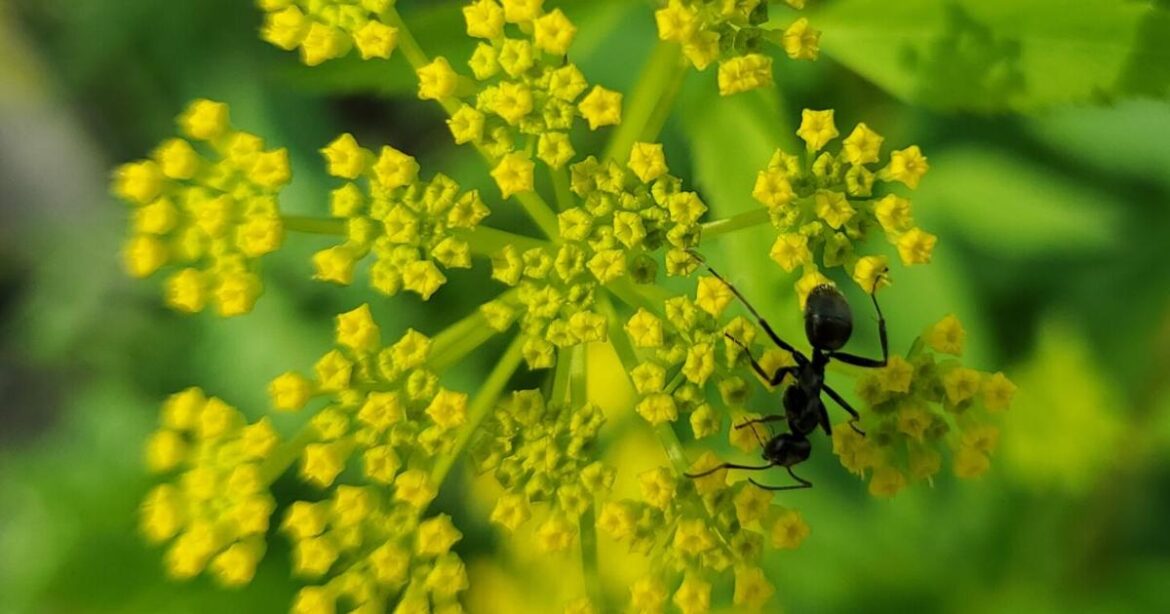Ants and plants have an interesting relationship that is often not as obvious as other insect and plant interactions. These industrious insects can be seen on a wide range of plant parts from limbs in the upper canopy of trees to the flowers of ground-hugging plants, such as wild ginger. Its safe to say that ants are always on the scene and busy doing something. However, its not always apparent what ants are up to, and I always have been fascinated to learn about their interesting interconnections with other species.
Every year, I receive reports from folks seeing ants on flowers. In some cases, clients are concerned about a problem or infestation that may impact their plant. In other cases, people want to know if these ever-roaming creatures are beneficial, helping the plant with vital processes such as pollination.
Perhaps one of the most noted interactions observed in the garden space is the presence of ants on peony buds or flowers. It’s pretty much a given that if you have peonies, you have ants hanging around. Opinions about this situation are wide ranging, from the negative view that ants need to be controlled, to the “do nothing” attitude of many.
In this case, ants are attracted to the flower buds by nectar released from green leaf-like structures, called sepals. Since ants actively defend their food sources, they stay pretty busy running off other insects and, in turn, protecting the peony flower from predation.
There are other cases where plants have developed nectary glands at locations outside of flowers, such as on partridge pea (Chamaecrista fasciculata). This plant has nectary glands at the base of leaves, although they are absent on flowers. Catalpa (Catalpa speciosa) trees also have nectary glands on their leaves, but also have them in their flower structures. These trees have been found to release more nectar when damaged, which generates more insect interest in the damaged leaf structure. In both of these cases, we believe these nectar glands exist to attract insect predators like ants that defend the plants from herbivory. So, maybe ants should be considered the heroes of the plant world?
Earlier this week, I was observing ants on the flowers of golden Alexanders (Zizia aurea). This native plant is in full bloom right now and has been providing some spectacular color in the garden the past few weeks. As I watched the tiny ants moving busily around clusters of golden flowers, it made me wonder how much they may or may not contribute to pollination. Are they serving as guards in this case or helping with reproduction? Or is their pursuit of nectar a selfish act in this example?
Golden Alexanders is capable of self-pollination, so that leads me to believe it doesn’t rely heavily on insect pollinators. In addition, ants aren’t great collectors of pollen. They don’t have the massively hairy bodies of bees, which are some of the most efficient and effective pollinators. Bee bodies are covered in specially adapted hairs (positively charged) which catch and release pollen on flower parts (negatively charged). However, ants are typically not that hairy and definitely do not possess electrostatically charged hair structures adapted for pollen collection.
In general, ants are considered to have a pretty minimal effect as pollinators. This is true of quite a few other insects, which may contribute to pollination in a small way but certainly don’t drive the process. Most of these interactions aren’t critical to reproduction or other process but do help one species or the other in some way.
There are times when ants may be on the wrong side of the plant world’s plight. Since they are often territorial and will protect food sources, this behavior can also be used to protect plant-damaging insects. Aphids secrete honeydew, which is sugary excrement resulting from destructive feeding on plant sap. Ants have been found to practice “aphid farming” in some cases where they protect an aphid population from other insect predators to ensure a steady supply of honeydew. So, which side are these guys on?
In my summation, ants probably are not the heroes of the plant world. However, at times, they can be considered the “tough guys,” kicking off “bad” insects and claiming plants as their turf, which is yet another example of the fascinating floral and faunal interactions all around us that make the ecological world tick.
Ryan Pankau is horticulture extension educator with University of Illinois Extension serving Champaign, Ford, Iroquois and Vermilion counties.

